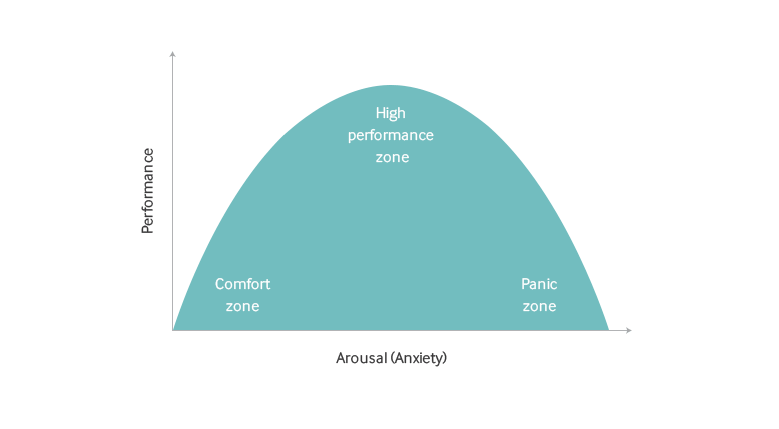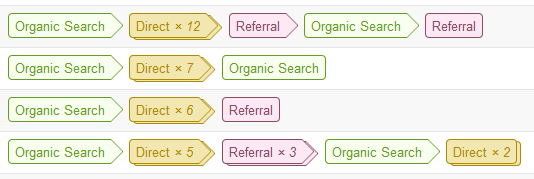- |
- |

The ‘comfort zone’ is a concept that we’re all familiar with. It has been written about many, many times, in a range of different contexts, from business to self-improvement and more.
The comfort zone can be defined as:
“… a behavioural state within which a person operates in an anxiety-neutral condition, using a limited set of behaviours to deliver a steady level of performance, usually without a sense of risk.”
In other words, your comfort zone is any type of behaviour that keeps your anxiety at a low level. Mundane activities such as watching TV are in your comfort zone. High anxiety activities like delivering a speech are outside that zone.
Anxiety is something we naturally try to avoid. When given the choice between two options, we’ll often choose the easier of the two, even though we know instinctively that the alternative may be the best option for us in the long run.
What many people don’t know is that a little bit of anxiety can actually lead to high performance. The relationship between arousal (anxiety) and performance is known as the Yerkes-Dodson law, and dates back to 1908:

As arousal (anxiety) increases, so does performance – at least up to a point. Too much anxiety and you’ll reach a tipping point beyond which performance will rapidly decline. But there is an optimal area of anxiety in which you can operate. This area of optimal anxiety is known as the ‘high performance zone’, often referred to as ‘flow’.
This is where your best work happens.
The digital marketers’ comfort zone
There’s something I like to call the digital marketers’ comfort zone. Just like the regular comfort zone, this is a zone in which our anxiety levels are kept to a minimum.
The comfort zone isn’t always a bad thing. We all need space where we can relax, reflect and recharge. But if we spend too long in the comfort zone, we start to accept the status quo, avoid risk, shy away from anything that could be rise to criticism and navigate towards the easy option. We get too comfortable.
And when we’re in this zone, we’re not performing at our optimum. Our campaigns get mediocre results, we get bored, feel uninspired, and our careers start to suffer.
In order to improve as digital marketers – both at an individual and an organisational level – we need to break out of our comfort zone, and push into the high performance zone.
Here are some examples.
Move from familiar tactics to risk, experimentation and testing
Digital marketing is rapidly changing. What worked five years ago may no longer be relevant. Search engines have changed, buyer behaviour has changed and competitors have caught up.
But, for some reason, we tend to accept the status quo. We listen to outdated advice, and stick with the same, old tactics that we’ve been using for years.
To get into the high performance zone, make your own mind up about what you read online, take risks, try new tactics and adopt a culture of experimentation and testing.
Note: This doesn’t mean experiment with your client’s budget (unless they give you permission). Do your own testing, and then apply those learnings.
If you’re working in SEO, and interested in testing, consider getting involved in the IMEC Lab.
Integration, not fragmentation
For a long time, digital marketers have been operating in silos. SEO specialists do SEO. PPC specialists do PPC. Social media specialists do social media.
In reality, this is a poor reflection of the customer journey. People don’t buy products via a single channel. They have many different touch points with a brand before they make a purchase. If you’ve ever seen one of these reports, you’ll know what I mean:

But, for some reason, many marketing teams are still structured in silos. The SEO team do SEO, the PPC team do PPC and the social media team do social media.
To get into the high performance zone, think holistically. Break away from your single-channel mentality, and start thinking about how real people interact with your brand.
If that means completely restructuring your marketing team, so be it. And if that’s a drastic move for your organisation, at the very least, get those teams to start talking to each other.
It’s not comfortable. It’s a difficult process to go through, but a high performance marketing team can only be achieved through integration.
Contribute, don’t lurk
You’d think the digital marketing industry is fairly active online. And, in comparison to other industries, it is. Digital marketers are a vocal bunch, constantly tweeting, sharing and posting.
But for every digital marketer who is active online, there are a tens, maybe even hundreds more, who lurk in the shadows, many of which are eager to get involved, but secretly afraid of being challenged or criticised.
We know that we should be building our personal brand through blogging, social media, public speaking and so on, but many of us just don’t do it. Those things are way outside our comfort zone.
To get into the high performance zone, put yourself out there. Horrible cliché, I know, but important nonetheless. Contribute on social. Contribute to communities. Contribute to a blog. Start your own blog.
Don’t just follow people. Connect with people – online and offline.
When you’re at your next conference, don’t stand by the wall playing on your phone. Go and talk to a stranger. Get their details. Don’t just say you’ll follow up. Actually follow up.
Reporting and attribution
To this day, many digital marketers still assess campaign performance based on metrics such as visits, likes and shares.
We know that these metrics can be meaningless, but they’re easy to collect, easy to understand and easy to report on.
When we do report on more meaningful metrics, such as revenue, we make a mess of attribution, often using ‘last click’ as attribution models within our reports.
It’s comfortable being here. But it doesn’t mean it is right.
To get into the high performance zone, learn how to use analytics (whichever platform you use).
And that doesn’t mean learn how to use the interface. It means learn how to get the most out of it.
Learn how to incorporate non-standard data. Learn how to draw insights from the data. Learn how to properly attribute conversions, while being aware of – and accepting that – attribution is not an exact science.
Find out from your boss or your client what really matters to them, and then work out how to measure that.
It’s not comfortable. But it will lead to deeper insight, better decisions and longer-lasting relationships.
***
These are just a few examples. The high performance zone isn’t comfortable. You’re operating in a state of anxiety; uncertain of outcomes and fearful of failure.
It’s important to return to your comfort zone from time to time. Spend too long in the high performance zone and you’ll run out of steam.
It’s also important not to push too far. When demands become too great to handle, we become frazzled and performance suffers.
But if you keep pushing into the high performance zone on a regular basis, you’ll quickly become comfortable with a range of new activities. A new comfort zone.
So here’s my challenge to you. If you feel stagnated, uninspired and lacking motivation, there’s a chance you’ve been in your comfort zone for too long.
Face your fear. Find something that challenges you, and make it happen. If it goes well, celebrate success. If it doesn’t, celebrate that you gave it a shot.
Just don’t do nothing.
More Articles
Up for some more?
Get your monthly fix of August happenings and our curated Super8 delivered straight to your inbox.
Thanks for signing up.
Stay tuned, the next one isn't far away.
Return to the blog.